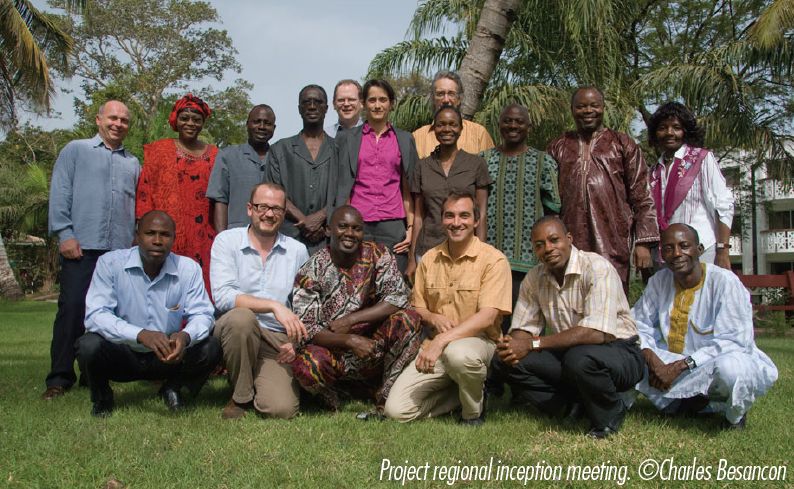Many training workshops were held throughout the project lifetime in order to increase understanding of how climate change is likely to impact biodiversity and protected areas in the West Africa region.
● Regional inception meeting (Banjul, The Gambia, March 2011): In addition to launching the project, initial training was provided at the meeting on a number of scientific topics, notably on protected areas and World Database on Protected Areas (WDPA), regional climate modelling and regional climate information, climate change adaptation and modelling climate change impacts on biodiversity, the role of conservation planning in assessing and mitigating climate change impacts on protected areas, and transboundary protected areas.

● National inception meetings and data collection (Ndjamena, Chad; Lomé, Togo, Bamako, Mali; Freetown, Sierra Leone; Banjul, The Gambia, December 2011): The national inception meetings held in each of the project countries also provided an opportunity for training a higher number of participants (from government, NGOs and universities) on topics associated with climate change and protected areas.
● Regional training workshop on climate information to enhance the resilience of West African protected areas (Freetown, Sierra Leone, April 2012): The aim of the workshop was to provide training to representatives of the Met Services from project countries, as well as other West African countries, in basic methods of analyzing climate data, and to promote the importance of weather and climate for biodiversity. A secondary aim was to explore mechanisms and identify best practice for the Met service of each country to enhance communication with protected area managers and ministries relating to wildlife, forestry and/or the environment.
● Regional workshops on species extinction risks and climate change vulnerability (Lomé, Togo, July 2012): The objective of the workshop was to gather national and international species experts on different taxa (reptiles, freshwater fish and mammals) to assess their climate change vulnerability based on their biological traits (as explained in the section above on Traits-based Vulnerability Assessments), as well as the extinction risk of reptiles (other taxa having already been assessed). Participants were taught the methodology and subsequently assessed the vulnerability of 317 reptile, 417 mammal and 550 freshwater fish species.
● National training workshops on climate information and species vulnerability to climate change (Freetown, Sierra Leone, and Banjul, The Gambia, April 2013; Lomé, Togo, November 2013): The main objective of these workshops was to build capacity on how to better link climate and climatic variability to the health of particular species populations. The specific objectives were to provide the participants with a better understanding of the results of climate models and species vulnerability assessments in their country, and the capacity to disseminate them; to build capacity to identify appropriate, speciesspecific, adaptive actions, and weigh up the pros, cons and possible barriers to their implementation; and to teach participants to develop risk assessments containing details of selected vulnerable species and their associated traits, climatic variables of importance, and possible adaptive responses.
● Regional training workshop on assessing the vulnerability of biodiversity and protected areas to the impacts of climate change (Ouagadougou, Burkina Faso, July 2013): The main objective of the workshop was to build capacity on (i) Understanding the impacts of climate change on biodiversity and PAs, (ii) Carrying out vulnerability assessments and interpreting the results of species distribution models; and (iii) Planning and implementing adaptation actions.
● Regional training workshop on systematic conservation planning (Accra, Ghana, July 2014): The main objective of the workshop was to build capacity on systematic conservation planning, gap analysis and the identification of conservation priority areas. The workshop addressed the following question: Where should countries consider designating new PAs in the light of climate change and given global commitments to reach 17% terrestrial coverage? This involved looking at (i) What are the current PA systems protecting and which species are missing now and/or potentially in the future under climate change?, and (ii) What is the best way to fill those protection gaps? To ensure the relevance of the national conservation planning systems produced by the project, the training also included the following themes: principles of systematic conservation planning approach for identifying where to locate new PAs; the theory of gap analysis and how to set appropriate conservation targets; using the CLUZ and Marxan software to identify priority areas; and developing a data collection plan to ensure relevant information is collected for inclusion in the national systems.
● National training workshops on systematic conservation planning (Banjul, The Gambia, February 2015; Lomé, Togo, March 2015): The main objective of the meetings was to design national systematic conservation planning systems for each of the five project countries. Specific goals were for participants to (i) Understand the principles of systematic conservation planning; (ii) Gain a basic knowledge of how to undertake a gap analysis, set protection targets, and use Q-GIS, CLUZ and Marxan software; and (iii) Create draft national systematic conservation planning systems to be later refined based on the participants' feedback (see the final outputs presented in the section above).
All the references relative to the training provided throughout the project can be found in the project training manual. The manual is available in both English and French and divided into six modules: 1. Protected Areas and the WDPA; 2. Climate data and scenarios; 3. The IUCN Red List of Threatened Species; 4. Species Vulnerability Traits; 5. Species Distribution Modelling; and 6. Conservation Planning.











